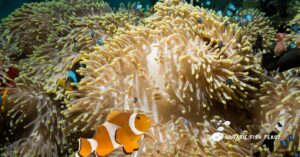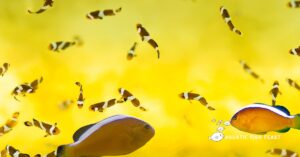To answer the question, “Can clownfish live in freshwater?” The answer is simple: My experience with them has shown that clownfish cannot thrive in freshwater environments due to their acclimation to the hypertonic conditions present in saltwater.
Clownfish would swell to death if hypotonic liquids, like freshwater, were introduced to them. In contrast, euryhaline animals may survive in both freshwater and saltwater settings.
I’ll go into the process that could keep your clownfish from surviving in freshwater as we proceed.
I’ll also address whether clownfish can adapt to freshwater tanks and probably the primary distinctions between freshwater and saltwater aquariums.
Now, let’s get started.
Table of Contents
Can clownfish survive in freshwater
One common factor about clownfish is that they love to stay around their counterparts, “sea anemones.” Maybe that is why they prefer saltwater to freshwater.
Studies have shown that they cannot survive long if placed in freshwater.
Here are 5 key points to look into:
1. Osmoregulation of clownfish
Clownfish are adapted to places that have higher levels of salt concentration.
That is one of the differences between seawater and freshwater.
They rely on specialized glands called kidneys to regulate the amount of salt in their bodies.
Their cells would swell up and burst in freshwater due to an influx of water from the lower salt environment.
2. The Ionic composition of a clown fish
Clownfish survive easily where you have a high level of ionic composition, and the level of ions in seawater is quite different when it comes to freshwater.
Seawater contains higher ions, such as sodium, magnesium, calcium, and potassium,, which clownfish need to maintain homeostasis.
Without these ions, clown fish cells hardly function properly in such an environment.
3. Their Gill function
The gills of clownfish are designed to actively take in saltwater and remove excess salt through specialized gill plates and lamellae.
In freshwater, their gills would not be able to remove salt from the bloodstream, leading to toxicity effectively.
4. The osmotic balance of Clown Fish
Through active transport, clownfish cells have developed a higher internal salt concentration than the surrounding seawater.
This maintains an osmotic balance. In freshwater, osmosis would cause their cells to swell with water and burst due to a hypotonic environment.
5. Absence of symbiotic anemone
Clownfish have a long survival nature with the sea anemones in the wild.
This is because the clownfish gains protection from predators in exchange for providing nutrition for anemone.
Clownfish are more vulnerable in freshwater without access to their natural host anemone.
So, you can now see that clownfish have very specialized physiological adaptations for surviving in marine conditions.
A transition to freshwater upsets their osmotic, ionic, and symbiotic balances – making long-term survival unlikely without careful acclimation and specialist care.
Most of them are freshwater fish and have clowns as a preceding word.
When we talk about “clownfish,” we most often mean one of the marine (saltwater) species belonging to the Pomacentridae family (subfamily Amphiprioninae).
The kidneys and gills of a clownfish are not made to withstand freshwater, and they won’t be for a few thousand years, no matter how long you acclimate the fish or how many generations you raise.
If you’re determined to mimic the color palettes of a freshwater tank, consider keeping fish such as tiger barbs and kuhli loaches.
Why can’t clownfish live in freshwater
As outlined above, you would understand that clownfish have stayed for millions of years to thrive in seawater and rely on several biological adaptations.
That is why the clownfish can maintain homeostasis in a saline environment. Anytime they are shifted to freshwater, they experience severe osmotic stress that clownfish struggle to overcome:
- Their kidneys, gills, and cells are adapted for saltwater ion regulation and cannot compensate for the hypotonic shock of freshwater. This leads to rapid cell swelling and organ dysfunction.
- The ionic composition of freshwater lacks the optimal levels of salts like sodium, calcium, and magnesium that clownfish need for biological processes.
- Their symbiotic relationship with anemones, which provide camouflage and protection from predators, cannot be replicated in freshwater environments where these host species do not exist.
- Clownfish also lack behavioral adaptations for surviving in freshwater habitats. Factors like water temperature, pH, oxygen levels, predators, and food sources are all mismatched to their natural needs.
It is theoretically possible to gradually acclimate clownfish to brackish water conditions over multiple generations.
Most of them will not be able to survive a direct transfer to freshwater.
Their marine physiology leaves them exquisitely sensitive to even small changes in salinity.
So, in essence, clownfish are highly specialized for life in coral reefs and cannot easily override millions of years of evolution through captivity alone.
That is why they cannot truly live long-term in freshwater.
What saltwater fish can live in freshwater
Fish classified as euryhaline species can withstand a broad range of salinity at some point in their life cycle.
These species can live or survive in various salinities, from fresh to brackish to marine environments. They include salmon, eels, red drum, striped bass, and flounder.
However, eryhaline fish may require a period of progressive acclimatization or adjustment to endure significant variations in salinity.
As we delve into four species that survive and flourish in both settings, prepare to learn some new terms, such as euryhaline and osmoregulation.
1. Salmon
Although every species discussed here is diadromous, they fall into two categories: anadromous, which runs upward, and catadromous, which runs downhill, as you will learn later.
Among other animals, salmon are anadromous. In other words, they travel out into the ocean to develop after hatching in freshwater.
When fully mature, they make the arduous “upstream journeys” for which they are renowned, returning to freshwater breeding areas.
Salmon provide food for various species that travel upstream, including birds and bears.
Making several freshwater-saltwater transitions is difficult, and salmon species have developed sophisticated coping mechanisms to assist them in adapting to various aquatic environments.
Osmoregulation, the mechanism by which organisms maintain an internal fluid balance, accomplishes this.
Salmon have an unusual migratory pattern because of their ability to control their bodies to maintain a constant internal concentration of salt and water while they migrate.
2. Eels from America
Being catadromous, American eels spend most of their life in rivers, migrating downstream to the sea to reproduce.
Eels are born in saltwater and face several challenges as they migrate back up rivers and streams like salmon.
Eels are precious components of their environments because of their symbiotic connections with other living things.
For instance, during the last few weeks of their development, freshwater mussel larvae in the Chesapeake Bay and Susquehanna River, close to Ocean Conservancy’s headquarters in Washington, D.C., attach themselves to American eels.
Together, eels and mussels can filter and clean up to 15 liters of water daily, keeping these environments thriving with diverse biodiversity.
What type of water do clownfish live in
Fish that are marine (saltwater) in nature are called clownfish.
If placed in freshwater, they will perish within a few hours, if not sooner, because their kidneys and gills are not designed to manage it.
Clownfish like salmon, menhaden, and eels cannot adapt to freshwater or saltwater.
They are so lovely and fascinating, and maintaining a freshwater fish tank is far simpler than a saltwater one, so it would be great if they could.
Clownfish reside in anemones in protected reefs or lagoons found in warm seas like the Pacific and Red Seas.
Clownfish consume a variety of tiny invertebrates, algae, and leftover food that anemones leave behind.
Are there any freshwater clownfish
Freshwater clownfish are nonexistent. This kind of fish can only be found in saltwater; it is strictly marine.
Thus, clownfish cannot be added to a freshwater aquarium. To stock it, you will need to locate other species.
These Freshwater Fish Remind Us of Clownfish:
Still, certain freshwater fish bears a resemblance to clownfish. If you want those vivid orange, black, and white stripes in your aquarium, these can be an excellent substitute.
Among the choices you have are:
- Gobies with Bumblebees
- Plates of Clown Loaches Tiger Barbs
Final thought
Now that we have established that clownfish hardly live in freshwater, it’s not an anemone fish, but there is a type of freshwater fish that looks like a clownfish.
Clown Loach (Chromobotia macracanthus) is the name given to it. The clown loch is characterized by vivid orange and black stripes resembling the color of a clownfish.
Although species in the animal realm have always evolved traits to aid their survival, the capacity to live in fresh and saltwater is a special trait.
Diadromous fish perform a crucial ecological function in lakes, rivers, brackish watersheds, estuaries, and the open ocean by establishing vital links across habitats and assisting other species.
Other Article:




